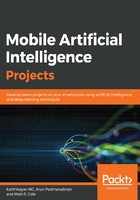
What this book covers
Chapter 1, Artificial Intelligence Concepts and Fundamentals, covers the main concepts and high-level theory required to build AI applications on mobile or the web. We discuss the fundamentals of Artificial Neural Networks (ANNs) and deep learning, which form the crux of the current research and trends in AI. We will come to understand all the essential terms required to start our journey on building AI applications.
Chapter 2, Creating a Real-Estate Price Prediction Mobile App, is the practical primer for the entire book. We will look at all the essential tools and libraries used throughout the book, and consider how to set up a deep learning environment. We will introduce these by showing how to build a real-estate price prediction app using TensorFlow, deploying it for consumption on mobile and the web. For this, we will be using ANNs and TensorFlow.
Chapter 3, Implementing Deep Net Architectures to Recognize HandWritten Digits, focuses on the essential theory, terms, and concepts associated with machine vision. We will get an intuitive understanding of how Convolutional Neural Networks (CNNs) work by applying machine vision in practice. We will gain an understanding of how to build real-world applications in machine vision. This chapter will be intuitive and application-focused, instead of theory-heavy.
Chapter 4, Building a Machine Vision Mobile App to Classify Flower Species, allows us to translate our learning from the previous chapters to build an object recognition app and then customize it to build an app to classify over 100 species of flowers and pull up their wiki pages. We will learn how to retrain existing Deepnet architectures for custom use cases in object and image classification.
Chapter 5, Building an ML Model to Predict Car Damage using TensorFlow, focuses on unsupervised tasks on image restoration using AI. It discusses the deepnets and libraries used for these tasks. We will explore techniques used in deep learning to solve and execute these tasks individually, and then we'll set up and run image restoration from Android and iOS apps.
Chapter 6, PyTorch Experiments on NLP and RNN, focuses on the workings of Recurrent Neural Networks (RNNs) and the applications of AI and NLP. We will deep dive into practically solving NLP use cases in AI.
Chapter 7, TensorFlow on Mobile with Speech-to-Text with the WaveNet Model, in this chapter, we are going to learn how to convert audio to text using the WaveNet model. We will then build a model that will take audio and convert it into text using an Android application.
Chapter 8, Implementing GANs to Recognize Handwritten Digits, in this chapter, we will build an Android application that detects handwritten numbers and works out what the number is by using adversarial learning. We will use the Modified National Institute of Standards and Technology (MNIST) dataset for digit classification. We will also look into the basics of Generative Adversarial Networks (GANs)
Chapter 9, Sentiment Analysis over Text Using LinearSVC, in this chapter, we are going to build an iOS application to do sentiment analysis over text and image through user input. We will use existing data models that were built for the same purpose by using LinearSVC, and convert those models into core machine learning (ML) models for ease of use in our application.
Chapter 10, What is Next?, discusses the popular ML-based cloud services and where to start when you build your first ML-based mobile app, and also some references for further reading.